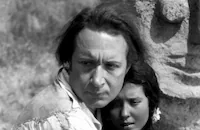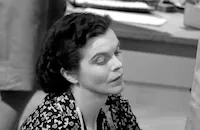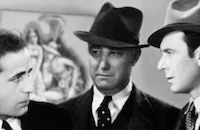Montana

Brief Synopsis
Cast & Crew
Ray Enright
Errol Flynn
Alexis Smith
S. Z. "cuddles" Sakall
Douglas Kennedy
James Brown
Film Details
Technical Specs

Synopsis
In the Montana territory, in 1871, sheepherders invade land occupied by cattle ranchers. Morgan Lane, a sheepman whose father was driven off his land by cattlemen, returns to Montana, determined to graze sheep. After one of his herders is killed, Morgan accompanies Poppa Schultz, a traveling salesman, into town, and he presents himself as Poppa's partner. The opposition to the sheepmen is led by cattle ranchers Maria Singleton, whose father was killed in a sheep and cattle war, and her fiancé, Rod Ackroyd. Still pretending to be a salesman, Morgan asks the ranchers about their hostility to sheep. His questions raise the suspicions of cattle rancher Slim Reeves, who challenges him to a gunfight. Later, Tecumseh Burke, an old cowhand, privately reveals to Morgan that he knows his real identity. Later, Maria invites Morgan to dinner with Rod and George Forsythe, who owns the land adjoining Maria's ranch. During the evening, Morgan bets Rod a portion of his land that he can ride any horse on the property. Rod selects a horse that is reputed to be a killer and, to make sure that Morgan loses, cuts the stirrup. Even so, Morgan almost wins his bet. Later, Maria offers to lease some land to Morgan, whom she still believes is interested in running cattle, and makes it clear how strongly she is opposed to sheep. After Morgan's intention to bring sheep onto the land is revealed, however, Reeves severely beats and tries to kill Morgan. Tecumseh saves Morgan and later explains that Reeves's fury stems from the fact that the small cattlemen are being squeezed out of business by the large ranchers. Morgan meets with them and suggests that they run their cattle along with sheep. Later, he tries to bring Forsythe in on their side by pointing out that the price of beef is declining while the price of wool is high. Forsythe is interested, but does not want to go against his neighbors, so he invites Rod and Maria to meet with Morgan and the other ranchers to work out a solution. Rod declines, however, partly because he plans to take advantage of Maria's absence to meet another woman, who is also the sheriff's girl friend. Maria and Forsythe argue about the pros and cons of allowing sheep on the land, and most of the ranchers support Maria. When Forsythe announces that he will allow sheep on his ranch, Reeves kills him. In retaliation, Morgan kills Reeves and a range war starts. The sheriff, who witnessed Rod's rendezvous with his girl friend, unofficially warns Morgan that Rod and Maria are planning to stampede their cattle and drive the sheep away. After a shootout, the sheriff, Morgan and his associates stop the stampede, but Rod is trampled to death. Maria then takes a stand against the sheep and wounds Morgan while trying to stop them from entering the town. She instantly regrets it, however, and as she and Morgan embrace, concedes that sheep and cattle ranchers can live together.

Director
Ray Enright
Cast

Errol Flynn

Alexis Smith

S. Z. "cuddles" Sakall

Douglas Kennedy
James Brown
Ian Macdonald

Charles Irwin
Paul E. Burns
Tudor Owen
Lester Matthews
Nacho Galindo
Lane Chandler

Monte Blue
Billy Vincent
Warren Jackson
Forrest Taylor
David Cota
Joe Dominguez
Carl Andre
Philo Mccullough
Almira Sessions
George Lee
Joseph J. Green

Dorothy Adams

Jack Mower
Creighton Hale
Maudie Prickett
Jessie Adams

Nita Talbot

Gertrude Astor
Crew
Milo Anderson
Lou Baum
G. W. Berntsen
David Buttolph
Borden Chase
Charles H. Clarke
Sidney Cutner
Mack David
Daniel Decatur Emmett
Karl Freund
William Fritzsche
Oren Haglund
Ernest Haycox
Al Hoffman
William Jacobs
Natalie Kalmus
Gene Lewis
Jerry Livingston
Charles O'neal
Frederick Richards
Francis J. Scheid
Leo Shuken
James R. Webb
Perc Westmore

Film Details
Technical Specs

Articles
Montana -
Smith was an elegant beauty whom Warner Brothers had cast for the previous nine years primarily, and decoratively, as socialite characters. Nonetheless she had managed to make a few films in other genres, including westerns, though she really yearned for the chance to make comedies and musicals -- a wish mostly denied by the studio. (An exception was the broad 1944 comedy The Doughgirls.) Montana, her last Warner Brothers picture, was a rather routine western, but Smith was happy to be paired with her good friend Errol Flynn, cast as an Australian sheep rancher setting down roots in 1879 Montana -- major cattle country. Smith plays a cattle rancher whose father was killed in a previous sheep vs. cattle range war, and she and Flynn even get the unusual chance to sing a duet on screen: "I Reckon I'm Falling in Love."
Smith had worked with Flynn on her first major movie, Dive Bomber (1941), and again in Gentleman Jim (1942) and San Antonio (1945). Smith's husband, actor Craig Stevens, later said that Smith and Flynn had struck up a great friendship on Gentleman Jim, but that Flynn, a notorious womanizer, kept his hands to himself. "He had feelings for her," Stevens told author Daniel Bubbeo, "but he also had great respect for her. He treated her with dignity, respect and humor. He never made a pass at her." Years later, shortly before his death in 1959, Flynn invited Smith to lunch on the Warner Brothers lot. When she came home, Stevens recalled, "there were tears in her eyes." Smith said that Flynn had told her "he knew he didn't have much longer to live. He wanted to tell me how much he enjoyed working with me and also that he loved me."
Author Bubbeo wrote that Smith and Stevens were so inseparable by the time of Gentleman Jim that it's very unlikely she would have gotten involved with Flynn in any case. Though Stevens had had a small part in Dive Bomber, the two really developed their romance on their next film, the B title Steel Against the Sky (1941), at the end of which their characters got married! In real life, they would marry in 1944, a union that lasted just shy of forty-nine years until Smith's death.
Warner Brothers did not renew Smith's contract after Montana, Stevens said, because "they didn't want to pay the gain in her contract." But she was not bitter and went on working independently for other studios. Soon she was acting for Frank Capra in a picture she had really wanted to do: Here Comes the Groom (1951). And later in her life she finally got the chance to sing her heart out when she turned to the stage, most memorably in Stephen Sondheim's Follies (1971), for which she won the Tony Award for Best Actress in a Musical.
Errol Flynn had already made plenty of other westerns by the time of Montana, including Dodge City (1939), Santa Fe Trail (1940), They Died with Their Boots On (1941) and San Antonio, among others. As Jeanine Basinger has written, "it's a credit to Flynn's strong screen personality that he could appear in American westerns and seem right at home on the range" -- since his features, accent and physique are not really what we usually think of as "western."
Flynn's wild off-screen life prompted studio chief Jack Warner to hire a private detective, posing as an extra, to keep an eye on Flynn and make sure he wasn't drinking or using drugs. Flynn got wind of the detective and one afternoon noticed him climbing a ladder to a hayloft -- presumably to spy on Flynn. Flynn took the ladder away and stranded him there overnight.
Reviews of Montana were lukewarm, with most criticizing it for unoriginality, the same old concept of sheepherders vs. cattlemen that had been seen many times before. The gorgeous Technicolor photography by Karl Freund was roundly praised, however. Freund used his own newly-designed light meter for the first time here. Called the Spectra, it was, according to the production notes, "a color temperature meter designed to eliminate guesswork and the human variable from color photography. The Freund instrument is the first device to undertake direct readings of the quality of light measured in degrees of Kelvin."
Montana was directed by Ray Enright, who had previously worked with Alexis Smith on the 1949 western South of St. Louis. Some sources, however, indicate an uncredited Raoul Walsh also directed parts of this picture.
Flynn was coached for his singing debut by actor and friend Dennis Morgan.
By Jeremy Arnold
SOURCES:
Jeanine Basinger, The Star Machine
David Bret, Errol Flynn: Satan's Angel
Daniel Bubbeo, The Women of Warner Brothers: The Lives and Careers of 15 Leading Ladies

Montana -
Quotes
Trivia
Notes
According to a July 15, 1947 Los Angeles Times news item, Thames Williamson was first assigned to write the screenplay for the film, and Vincent Sherman was to direct. A December 2, 1947 news item in Los Angeles Examiner reported that Ronald Reagan was to star in the film, which at that time was to be directed by Raoul Walsh. Studio press material states that this was the first film to use director of photography Karl Freund's newly developed "Spectra" device, a color temperature meter which was designed to eliminate the guesswork from color photography.















